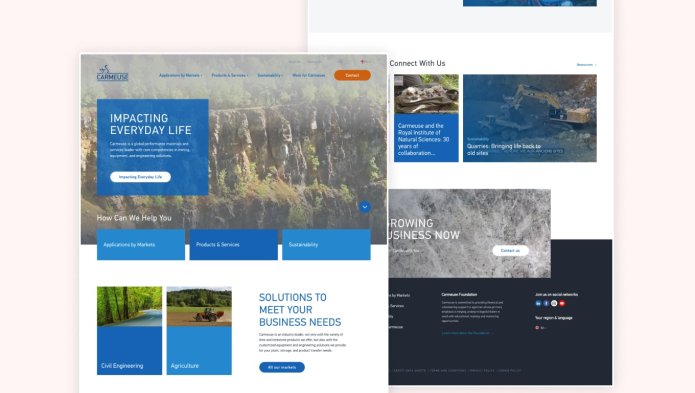Drupal ? Who is it for ?
The latest version, Drupal 9 (version 10 is planned for June 2022), is constantly innovating to become a leading platform for interactivity, customisation and adaptability. Its evolution also supports the integration of CRM, e-commerce, marketing, SEO and automation.
Although Drupal is a powerful CMS (Content Management System) for any type of website, it is particularly suited to large-scale sites. That' s why it is so popular and is the number one platform for web content management among worldwide companies, governments, higher education institutions and NGOs.
Such companies need a reliable and mobile-friendly website, but also a platform that can be used by different editors simultaneously, and from anywhere in the world. This is what Drupal provides. Examples include NASA, Le Figaro, Tesla and the Australian government.
For more information on Drupal and its applications, please read our article "What is Drupal?
Content creation
Web editors and administrators can easily create content on Drupal, without any technical skills, using a WYSIWYG (What You See is What You Get) editor. This editor allows you to write, edit or add content easily, just as you would do with a Word document. Thanks to different buttons, you can also add images, hyperlinks or change the size or colour of texts.
Language management
What is it about Drupal that attracts businesses around the world? If we take Tesla's website as an example, the first thing we see on the homepage is a menu allowing us to choose the language to visit the site. It is quite obvious that one of the main attractions of Drupal is the ease with which it is possible to create a multilingual site. A company located in Europe, with a branch in China, that wants to sell in the Philippines can easily set up a translation of its site.
This is exactly what we have done for our client Carmeuse.

It is also very easy to add languages as your business grows. If you only sell in Germany at the beginning, but business is booming and you want your site to be accessible to Italian people, it is possible to do this with little investment. It is also natively very easy to add other countries to Drupal. Including countries with multiple languages like Belgium.
Our client Leonidas is in exactly the same situation.

Adaptability and customization
It's not just languages that are easy to add. Drupal has the much appreciated feature of being able to adapt to the evolution of the business. A small business that grows can also expand the ambitions of its website. This is because of the way Drupal is built: modules (code extensions) can be added to a solid base to add functionality to the site, or to enhance existing ones. It is a very robust system.
Social network sharing, calendar, CAPTCHA or even Metatags for SEO, there are thousands of plugins that will allow you to customise your site as you wish. These plugins are generally provided by developers who contribute to the CMS (Content Management System) on a voluntary basis or as part of their job.
The Open Source community
Anyone is free to contribute, and after validation, see their work used by hundreds of websites. This is called open-source. Drupal is made available to the public for free. The open-source basis of Drupal allows it to be extremely flexible, since no big boss makes decisions for everyone. Your contribution to Drupal provides support for every vision of the CMS.
Likewise, if you have a specific need for your website, there is bound to be someone who has already thought of it, perhaps even developed it. This is only possible thanks to the large Drupal community. Drupalists form a large community that contributes every day to the proper functioning of the CMS.

Since it is constantly updated, Drupal follows web standards closely. Its constant evolution is highly appreciated, as it is continuously improved by the community.
Open-source, up to date, modular... All the qualities are gathered so that your site is "portable": it is not linked to the company or the developers who created your site. You want to change your provider? No problem, another company specialising in Drupal can easily pick up where they left off.
Roles and permissions
One of the most useful features of Drupal is the concept of Permissions. Drupal is designed from the start so that site-builders can define the permissions allocated to users. Certain parts of the back office are open to them and content creation is often assigned to them, as well as certain parts of the administration. By creating the "Content Editor" role and assigning it to a Drupal user, he will be able to log in and do only what they are allowed to do.
For larger sites, such as a news site like the BBC, journalists could be assigned a specific role, whose members would have permission to post on the blog. It is also possible that not all of these journalists even live in the UK and speak English as a second language. From anywhere in the world, they can log on and post in their native language. Another role could be given to the editor-in-chief, allowing him or her to update the homepage, using articles posted by journalists. This management of access to the site for the various stakeholders makes the CMS much easier to use.

A powerful search function
Search functionality alone justifies the use of Drupal over other CMS. Websites with a large database can be slowed down by this feature. The use of Apache Solr allows complex searches and very precise indexing that includes files and searches from other sites. A good example of the use of this tool can be found on the site of our client Erasme (University Hospital) whose advanced search required a powerful tool.
Flexible integration and migration
Drupal is extremely flexible and allows integration of your own API's or third party API's (application programming interface) that enable server to server communication, facilitating the exchange of information such as content, user data or rich media.
It is also inherently equipped to handle content migrations, even for large sites. A developer could do this manually with a basic site content, but such a migration becomes risky for a site with large content. Drupal is therefore the most suitable to perform this operation without risk.
Security
If implemented and maintained correctly, Drupal has proven to be one of the most secure CMS on the market. Mature, stable and security-oriented, it has been embraced by the largest organisations.
In short, Drupal is often the best choice for complex, content-intensive, high-traffic sites. It is extremely powerful, flexible, functional and secure. It is generally best suited for sites with large databases. WordPress may be easier to use, but it lacks depth and power when it comes to building a professional and ambitious website.
Any question about Drupal?



